
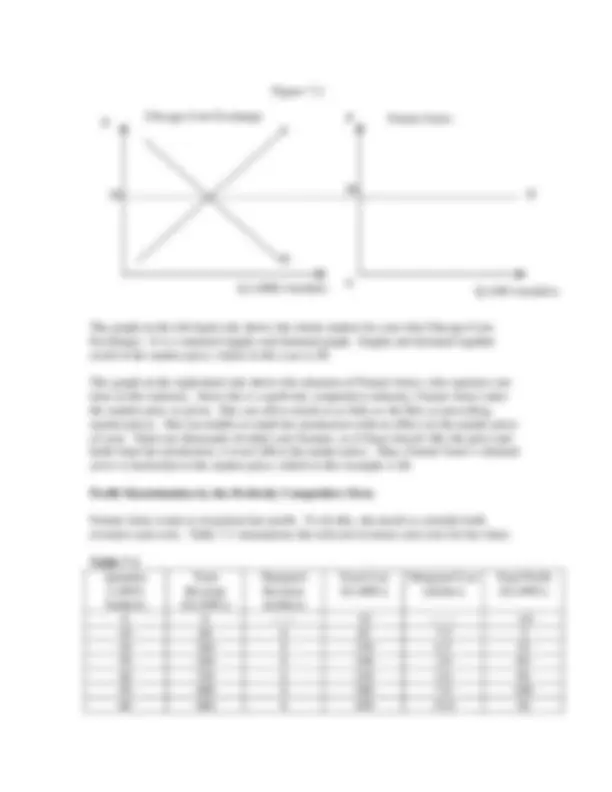
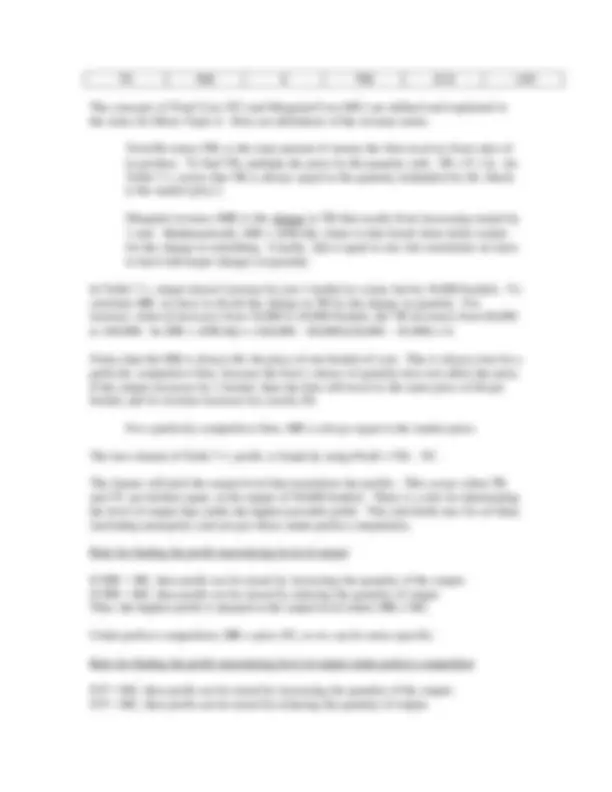
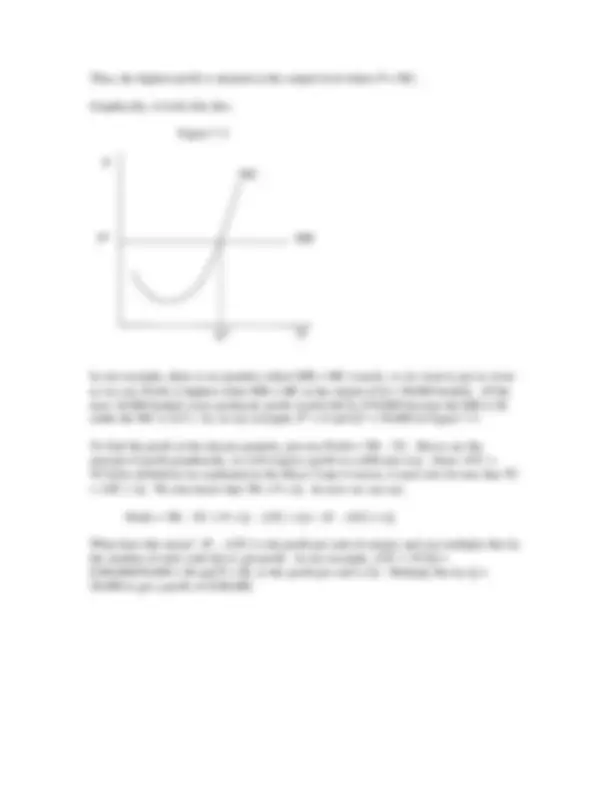
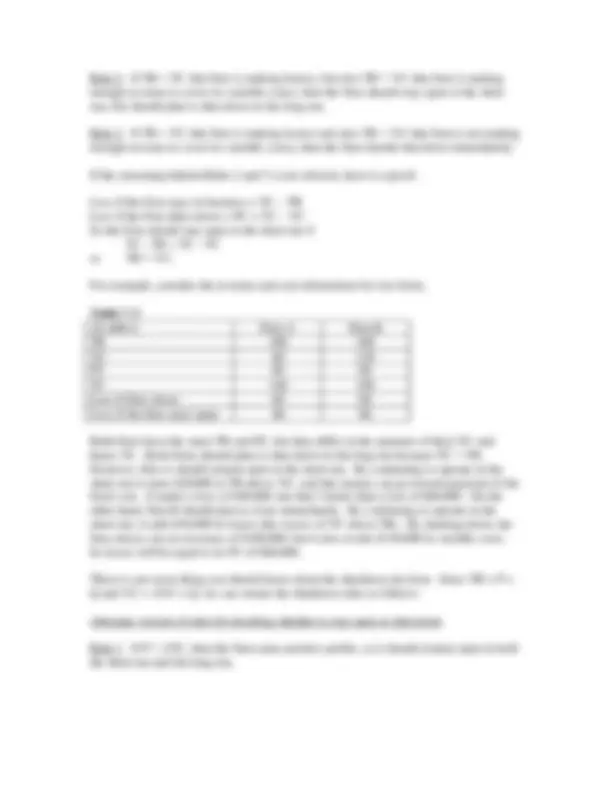
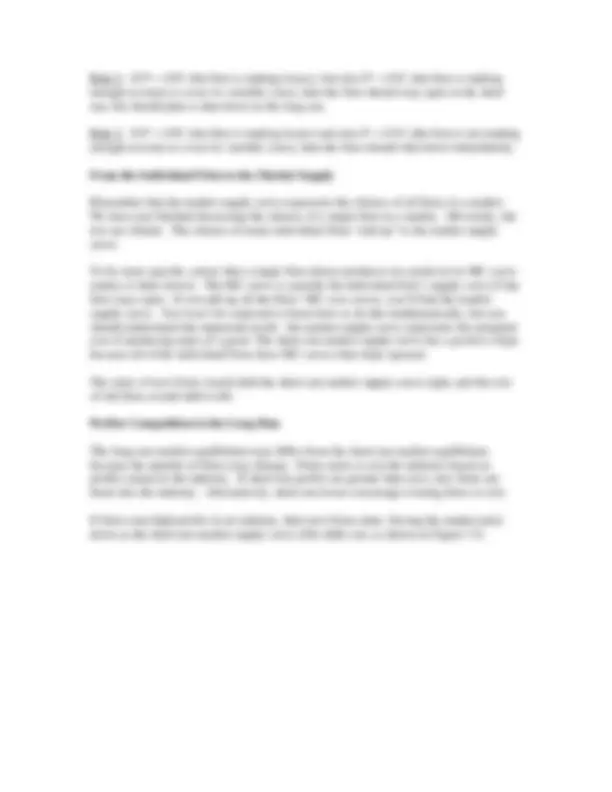
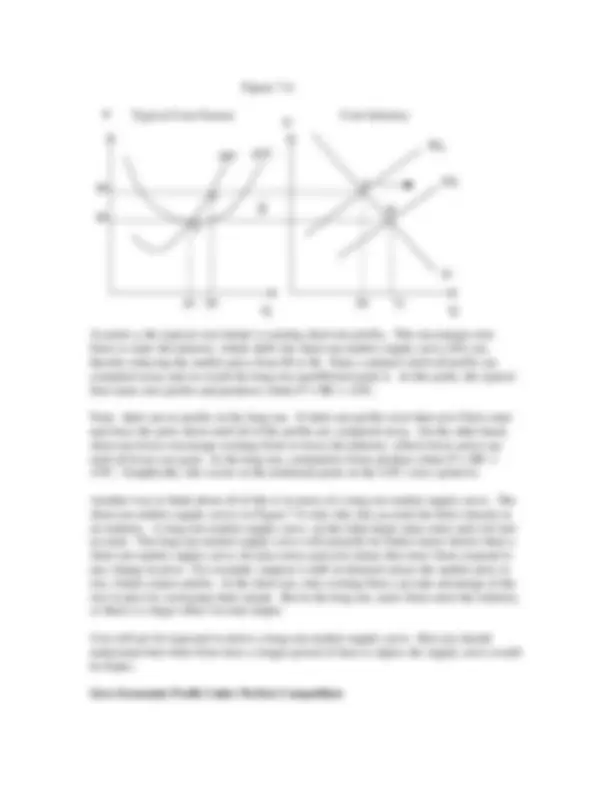
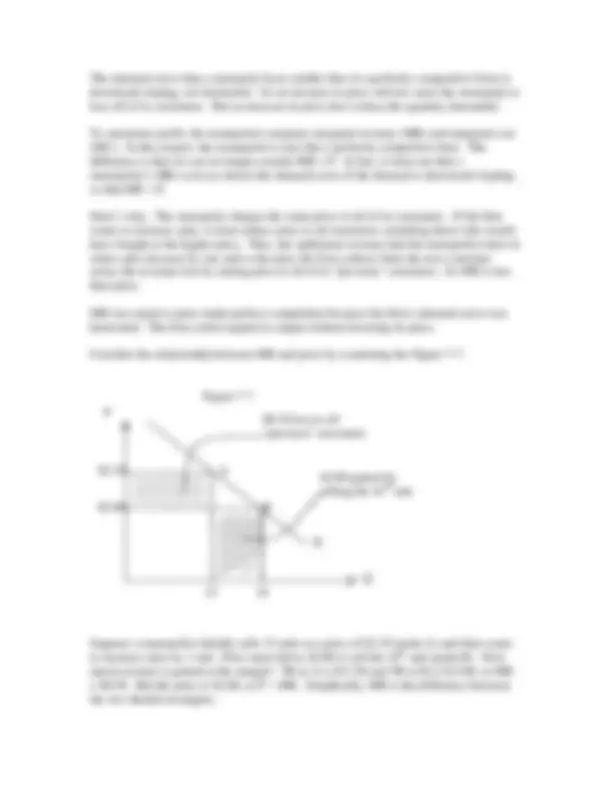

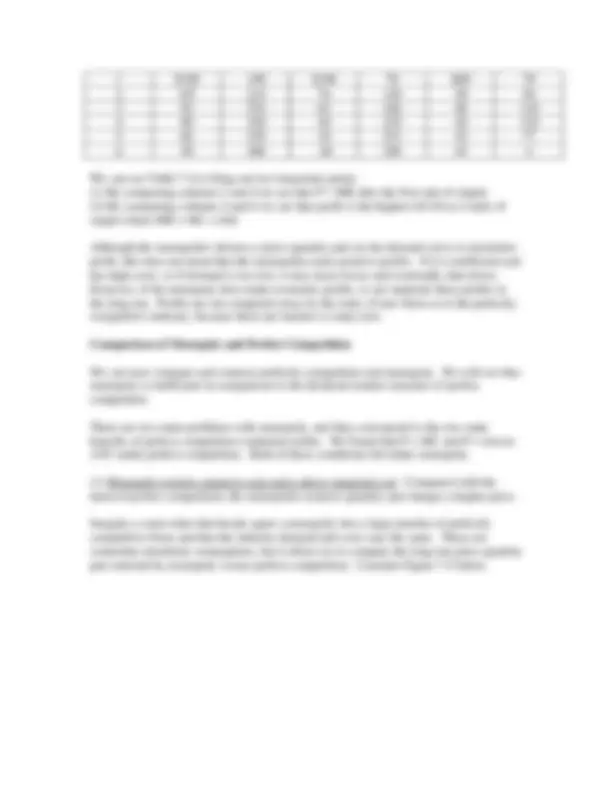


Study with the several resources on Docsity

Earn points by helping other students or get them with a premium plan


Prepare for your exams
Study with the several resources on Docsity

Earn points to download
Earn points by helping other students or get them with a premium plan
Community
Ask the community for help and clear up your study doubts
Discover the best universities in your country according to Docsity users
Free resources
Download our free guides on studying techniques, anxiety management strategies, and thesis advice from Docsity tutors
An in-depth analysis of different market structures, focusing on perfect competition and monopoly. It explains how economists determine the characteristics of each market type, the differences between them, and their efficiency. The document also covers the profit-maximizing level of output for firms under perfect competition and monopoly, and the impact of new firms entering or exiting an industry.
Typology: Exercises
1 / 16

This page cannot be seen from the preview
Don't miss anything!










Microeconomics Topic 7: “Contrast market outcomes under monopoly and competition.”
Reference: N. Gregory Mankiw’s Principles of Microeconomics , 2nd^ edition, Chapter 14 (p. 291-314) and Chapter 15 (p. 315-347).
Types of Market Structure
A market is a set of sellers and buyers whose behavior affects the price at which a good is sold.
In this review we'll see that the type of market a firm operates in has a large impact on the firm's behavior. Firms have no control over price under perfect competition. But firms have tremendous control over price in a monopoly setting.
Economists describe different types of markets by: (1) the number of firms (2) whether the products of different firms are identical or different (3) how easy it is for new firms to enter the market.
The four major types of markets can be viewed on a continuum.
Perfect Competition
Monopolistic Competition
Oligopoly Monopoly
Figure 7-
Perfect competition is at one extreme with many small firms selling identical products. Monopoly is at the other extreme with just one firm. The intermediate cases are monopolistic competition (which involves many small sellers producing slightly differentiated products) and oligopoly (which involves a small number of large firms).
Most U.S. firms operate under monopolistic competition (e.g., novels, movies, clothing, etc.) or oligopoly (tennis balls, crude oil, automobiles, etc.). However, this review will focus on the two extremes: perfect competition and monopoly.
There are three conditions required for perfect competition. (1) Numerous small firms and customers. The decisions of individual producers and buyers do not affect the price of the good.
(2) Homogeneity of product. The products offered by sellers are identical. For example, wheat of a particular grade is homogeneous (while ice cream is not). If the product is homogeneous, consumers don't care from which firm they buy the good because their products are identical. (3) Freedom of entry and exit. There are no barriers to enter the industry, so new firms can compete with old ones relatively easily. They do not have to match the advertising of the existing firms to secure customers. Nor are there large fixed costs that require large investments in equipment before production can start. There is also freedom to exit, so firms can leave the industry if the business proves unprofitable.
These three conditions are infrequently met, so perfect competition is pretty rare in the U.S. One good example is a company's stock. There are millions of buyers and sellers, the shares are identical, and entry into the market is easy. Other examples include fishing and farming.
If this market structure is so rare, then why are we bothering to study it? First, perfect competition often provides a reasonable approximation of what happens in markets that are less than perfectly competitive. Second, perfect competition is the standard by which all other markets are judged. We will see that markets work most efficiently under perfect competition. It insures that the economy produces what consumers want while using society’s scarce resources most effectively. By studying perfect competition, we will see what an ideally functioning market system can accomplish. Later on, we will see how far monopolies deviate from this ideal.
The Perfectly Competitive Firm and its Demand Curve
Under perfect competition, the firm must accept the price determined in the market. The firm is a price taker --it can produce as much or as little as it likes without affecting the market price. Each firm must match the price offered by its competitors because the products are identical. Otherwise, consumers will shift their purchases to another firm.
The price in the industry as a whole, which is comprised of all the individual firms and consumers, is determined by supply and demand. For a basic discussion of supply-and- demand, see the notes for Micro Topics 3 and 4.
Figure 7-2 shows how a single firm’s demand curve results from the price on the market as a whole.
The concepts of Total Cost (TC) and Marginal Cost (MC) are defined and explained in the notes for Micro Topic 6. Here are definitions of the revenue terms.
Total Revenue (TR) is the total amount of money the firm receives from sales of its product. To find TR, multiply the price by the quantity sold: TR = P × Q. (In Table 7-1, notice that TR is always equal to the quantity multiplied by $8, which is the market price.)
Marginal revenue (MR) is the change in TR that results from increasing output by 1 unit. Mathematically, MR = ∆TR/∆Q, where ∆ (the Greek letter delta) stands for the change in something. Usually, ∆Q is equal to one, but sometimes we have to deal with larger changes in quantity.
In Table 7-1, output doesn't increase by just 1 bushel at a time, but by 10,000 bushels. To calculate MR, we have to divide the change in TR by the change in quantity. For instance, when Q increases from 10,000 to 20,000 bushels, the TR increases from 80, to 160,000. So MR = ∆TR/∆Q = (160,000 – 80,000)/(20,000 – 10,000) = 8.
Notice that the MR is always $8, the price of one bushel of corn. This is always true for a perfectly competitive firm, because the firm’s choice of quantity does not affect the price. If the output increases by 1 bushel, then the firm still receives the same price of $8 per bushel, and its revenue increases by exactly $8.
For a perfectly competitive firm, MR is always equal to the market price.
The last column of Table 7-1, profit, is found by using Profit = TR – TC.
The farmer will pick the output level that maximizes her profits. This occurs when TR and TC are furthest apart, at the output of 50,000 bushels. There is a rule for determining the level of output that yields the highest possible profit. This rule holds true for all firms (including monopoly) and not just those under perfect competition.
Rule for finding the profit maximizing level of output
If MR > MC, then profit can be raised by increasing the quantity of the output. If MR < MC, then profit can be raised by reducing the quantity of output. Thus, the highest profit is attained at the output level where MR = MC.
Under perfect competition, MR = price (P), so we can be more specific:
Rule for finding the profit maximizing level of output under perfect competition
If P > MC, then profit can be raised by increasing the quantity of the output. If P < MC, then profit can be raised by reducing the quantity of output.
Thus, the highest profit is attained at the output level where P = MC.
Graphically, it looks like this:
Figure 7-
In our example, there is no quantity where MR = MC exactly, so we want to get as close as we can. Profit is highest when MR ≥ MC at the output of Q = 50,000 bushels. (If the next 10,000 bushels were produced, profit would fall by $70,000 because the MR is $ while the MC is $15.) So, in our example, P* = 8 and Q* = 50,000 in Figure 7-3.
To find the profit at the chosen quantity, just use Profit = TR – TC. But to see the amount of profit graphically, we will express profit in a different way. Since ATC = TC/Q by definition (as explained in the Micro Topic 6 notes), it must also be true that TC = ATC × Q. We also know that TR = P x Q. So now we can say:
Profit = TR – TC = P × Q – ATC × Q = (P – ATC) × Q
What does this mean? (P – ATC) is the profit per unit of output, and you multiply this by the number of units sold (Q) to get profit. In our example, ATC = TC/Q = $300,000/50,000 = $6 and P = $8, so the profit per unit is $2. Multiply this by Q = 50,000 to get a profit of $100,000.
loss is $5,000, which equals the per unit loss (ATC - P) of $0.167 x the quantity of 30,000. Graphically, it looks like this:
Figure 7-
The shaded area in Figure 7-5 shows losses. Since the ATC curve lies above the price, it is clear that the firm is losing money. But it would lose even more money if it produced a quantity other than Q*. This means that MR = MC is still the right decision rule to use when selecting the firm’s output level.
The Shutdown Decision
It is possible, however, that it would be better for the firm to produce nothing at all. Firms can't endure losses forever. The decision to shut down involves a comparison between short-run fixed costs (FC) and variable costs (VC). These concepts are explained in the Micro Topic 6 notes.
Recall that the FC cannot be avoided in the short run. The firm must pay its FC whether it stays open or shuts down. If the firm shuts down, TR = 0 and VC = 0, but the FC (or sunk costs) remains. Sometimes it is better to remain in operation until the fixed costs expire.
There are three rules that govern the shutdown decision. Note: these rules hold for all firms (including monopoly) and not just perfectly competitive firms.
Rules for deciding whether to stay open or shut down
Rule 1: If TR > TC, then the firm earns positive profits, so it should remain open in both the short run and the long run.
Rule 2: If TR < TC (the firm is making losses), but also TR > VC (the firm is making enough revenue to cover its variable costs), then the firm should stay open in the short run, but should plan to shut down in the long run.
Rule 3: If TR < TC (the firm is making losses) and also TR < VC (the firm is not making enough revenue to cover its variable costs), then the firm should shut down immediately.
If the reasoning behind Rules 2 and 3 is not obvious, here is a proof:
Loss if the firm stays in business = TC – TR Loss if the firm shuts down = FC = TC – VC So the firm should stay open in the short run if TC - TR < TC - VC or TR > VC.
For example, consider the revenue and cost information for two firms.
Table 7- ($1,000's) Firm A Firm B TR 100 100 VC 80 130 FC 60 60 TC 140 190 Loss if firm closes 60 60 Loss if the firm stays open 40 90
Both firms have the same TR and FC, but they differ in the amounts of their VC and hence TC. Both firms should plan to shut down in the long run because TC > TR. However, firm A should remain open in the short run. By continuing to operate in the short run it earns $20,000 in TR above VC, and this money can go toward payment of the fixed cost. It makes a loss of $40,000, but that’s better than a loss of $60,000. On the other hand, firm B should plan to close immediately. By continuing to operate in the short run, it adds $30,000 in losses (the excess of VC above TR). By shutting down, the firm misses out on revenues of $100,000, but it also avoids $130,000 in variable costs. Its losses will be equal to its FC of $60,000.
There is one more thing you should know about the shutdown decision. Since TR = P x Q and VC = AVC x Q, we can restate the shutdown rules as follows:
Alternate version of rules for deciding whether to stay open or shut down
Rule 1: If P > ATC, then the firm earns positive profits, so it should remain open in both the short run and the long run.
Typical Corn Farmer Corn Industry
a
b
Figure 7-
At point a, the typical corn farmer is earning short-run profits. This encourages new firms to enter the industry, which shifts the short-run market supply curve (SS) out, thereby reducing the market price from $8 to $6. Entry continues until all profits are competed away and we reach the long-run equilibrium point b. At this point, the typical firm earns zero profits and produces where P = MC = ATC.
Note: there are no profits in the long run. If short-run profits exist then new firms enter and force the price down until all of the profits are competed away. On the other hand, short-run losses encourage existing firms to leave the industry, which forces prices up until all losses are gone. In the long run, competitive firms produce where P = MC = ATC. Graphically, this occurs at the minimum point on the ATC curve (point b).
Another way to think about all of this is in terms of a long-run market supply curve. The short-run market supply curves in Figure 7-6 only take into account the firms already in an industry. A long-run market supply curve, on the other hand, takes entry and exit into account. The long-run market supply curve will naturally be flatter (more elastic) than a short-run market supply curve, because entry-and-exit means that more firms respond to any change in price. For example, suppose a shift in demand causes the market price to rise, which creates profits. In the short run, only existing firms can take advantage of the rise in price by increasing their output. But in the long run, more firms enter the industry, so there is a larger effect on total output.
You will not be expected to derive a long-run market supply curve. But you should understand that when firms have a longer period of time to adjust, the supply curve would be flatter.
Zero Economic Profit Under Perfect Competition
Why do firms stay in the industry if profits are zero in the long run? Because we are talking about economic profit, which is not the same as accounting profit. A firm making zero economic profit would be making positive accounting profit. For more explanation of this topic, see the notes for Micro Topic 1.
Zero economic profit indicates that firms are earning the normal economy-wide rate of profit (in the accounting sense). An industry whose capital receives a higher rate of return than capital invested elsewhere attracts capital into the industry. This shifts the short-run market supply curve out and reduces prices until economic profit equals zero. If capital invested in an industry receives a lower return than capital invested elsewhere, then funds dry up in the industry. This shifts the short-run market supply curve inward, which raises prices until economic profits return to zero.
Perfect Competition and Economic Efficiency
Perfect competition leads to great efficiency for two reasons.
First, the price ends up being equal to a firm’s marginal cost (P = MC), as explained earlier. This means that customers keep buying more of the product as long as the dollar value of consuming the good is greater than the additional cost of producing it. If the price were higher than MC, customers would buy less of the product, even though consuming more would produce added benefits greater than the added costs. That would be inefficient.
Second, in the long run competitive firms must produce where price equals the lowest point on their ATC curve. This means the product is produced at the lowest possible cost per unit. To put it another way, the output of competitive industries is produced at the lowest possible cost to society.
Monopoly
We have just described an idealized market system in which all firms are perfectly competitive. Now we turn to one of the blemishes of the market system -- the possibility that some industries may be monopolized -- and the consequences of such a flaw in the market system.
Definition of a pure monopoly: (1) There is only one firm in the industry. (2) There are no close substitutes for the good the firm produces. (3) There is some reason why the entry and survival of a competing firm is unlikely.
Thus, even the sole provider of natural gas in a city is not considered a pure monopoly, since other firms provide substitutes like heating oil and electricity.
Pure monopolies are rare in the real world, because most firms face competition from firms producing substitute products. If there is only one railroad, it still competes with
The demand curve that a monopoly faces (unlike that of a perfectly competitive firm) is downward sloping, not horizontal. So an increase in price will not cause the monopoly to lose all of its customers. But an increase in price does reduce the quantity demanded.
To maximize profit, the monopolist compares marginal revenue (MR) and marginal cost (MC). In this respect, the monopolist is just like a perfectly competitive firm. The difference is that we can no longer assume MR = P. In fact, it turns out that a monopolist’s MR is always below the demand curve if the demand is downward sloping, so that MR < P.
Here’s why. The monopoly charges the same price to all of its customers. If the firm wants to increase sales, it must reduce price to all customers, including those who would have bought at the higher price. Thus, the additional revenue that the monopolist takes in when sales increase by one unit is the price the firm collects from the new customer minus the revenue lost by cutting price to all of its "previous" customers. So MR is less than price.
MR was equal to price under perfect competition because the firm's demand curve was horizontal. The firm could expand its output without lowering its price.
Consider the relationship between MR and price by examining the Figure 7-7.
$0.10 loss to all "previous" customers
$2.00 gained by selling the 16 th unit
Figure 7-
Suppose a monopolist initially sells 15 units at a price of $2.10 (point A) and then wants to increase sales by 1 unit. Price must fall to $2.00 to sell the 16th^ unit (point B). How much revenue is gained at the margin? TR at A is $31.50 and TR at B is $32.00, so MR = $0.50. But the price is $2.00, so P > MR. Graphically, MR is the difference between the two shaded rectangles.
Consider the monopolist's output decision in Figure 7-8.
Figure 7-
Notice that the MR is drawn below the demand curve (D). Like a perfectly competitive firm, the monopolist maximizes profit by setting MR = MC. It selects point M in Figure 7-8, where quantity is 150 units. But point M doesn't tell us the price charged by the monopolist, because P > MR. We must look at the demand curve to find the price at which consumers are willing to buy the 150 units. The answer is given at point P. The price of $10 is higher than MR and MC, which both equal $8.
In order to show the monopolist’s profit, we would have to draw in its ATC curve. This is done in the same way we did it for perfect competition. Profit is still equal to TR – TC, or (P – ATC) x Q. If P > ATC at the profit-maximizing quantity, the firm is making a profit; if P < ATC, the firm is making a loss.
To summarize, here are the steps to analyze the price and quantity choices of a profit- maximizing monopolist: (1) Find the Q at which MR = MC to select the profit maximizing output level. (2) Find the height of the demand curve at that Q to determine the corresponding price. (3) Compare the resulting price with the ATC at the profit-maximizing Q to determine whether the monopolist earns a profit or suffers a loss.
We can also determine the monopolist's profit-maximizing quantity and price numerically. Consider the data in Table 7-4 for a monopolist.
Table 7- Quantity Price Total Revenue
Marginal Revenue
Total Cost Marginal Cost
Total Profit
0 ------ $0 ------ $10 ------ -$
Qm Qc
Pc
Pm
C
Figure 7-
The monopolist would maximize profit by picking quantity Qm and price Pm (point M). But as we learned earlier, perfect competition would result in price equal to MC. The only place on the demand curve where price equals MC is at quantity Qc and price Pc, so point C would result from perfect competition.
By comparing points M and C, we can see that the monopolist produces less output and charges a higher price than the perfectly competitive industry with the same demand and cost conditions. This is troubling, because it means that monopoly leads to an inefficient resource allocation. It would make sense to produce the units between Qm and Qc, because producing them would generate greater added value to consumers than added cost to producers. This is true because the demand curve is higher than the MC curve for units Qc - Qm.
Thus, resources are allocated inefficiently under monopoly, because too few resources are being used to produce the monopolized good. The reduction in welfare associated with the reduced monopoly output is called "deadweight loss." Graphically, the deadweight loss is the triangular area below the demand curve, above the MC, and between Qm and Qc. In Figure 7-9, the area MCB measures deadweight loss.
(2) A monopolist's profits persist. Barriers to entry create the second major difference between perfect competition and monopoly. Profits are competed away by entry into a perfectly competitive market. In the long run, firms can only hope to cover their costs, including the opportunity cost of capital and labor supplied by the firm's owners. But positive economic profits can persist under monopoly, if it is protected from competition by barriers to entry. The monopolist can grow rich at the expense of their customers. Such accumulation of wealth is objectionable to most people, and therefore monopoly is widely condemned. As a consequence, monopolies are often regulated by governmental agencies that try to limit the profits they can earn.